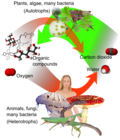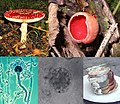A heterotroph (/ˈhɛtərəˌtroʊf, -ˌtrɒf/; from Ancient Greek ἕτερος (héteros) 'other' and τροφή (trophḗ) 'nutrition') is an organism that cannot produce...
28 KB (2,963 words) - 13:47, 23 August 2024
Myco-heterotrophy (redirect from Myco-heterotrophs)
food from parasitism upon fungi rather than from photosynthesis. A myco-heterotroph is the parasitic plant partner in this relationship. Myco-heterotrophy...
17 KB (1,617 words) - 08:43, 23 August 2024
Phototroph (redirect from Phototrophic heterotroph)
energy currency for the cell. Phototrophs can be either autotrophs or heterotrophs. If their electron and hydrogen donors are inorganic compounds (e.g....
8 KB (740 words) - 06:42, 16 August 2024
Carbon source (biology) (section Heterotrophs)
organism to synthesise biomass. Such sources may be organic or inorganic. Heterotrophs must use organic molecules as a source of both carbon and energy. In...
2 KB (481 words) - 09:12, 5 January 2024
Chemotroph (redirect from Chemotrophic heterotroph)
as a synonym of chemoautotrophy. Chemoheterotrophs (or chemotrophic heterotrophs) are unable to fix carbon to form their own organic compounds. Chemoheterotrophs...
9 KB (820 words) - 08:24, 24 September 2024
on 28 February 2018. Retrieved 25 February 2018. Bergman, Jennifer. "Heterotrophs". Archived from the original on 29 August 2007. Retrieved 30 September...
127 KB (11,347 words) - 12:56, 25 September 2024
that transfer energy in the anabolic processes of ATP synthesis (in heterotrophs) or biosynthesis (in autotrophs). The electron or hydrogen donors are...
19 KB (1,636 words) - 13:31, 17 June 2024
cyanobacteria gather energy directly from sunlight by photosynthesis. Heterotrophs including all animals, all fungi, all completely parasitic plants, and...
138 KB (14,771 words) - 17:34, 23 September 2024
and will be used as carbon and energy source by other organisms (e.g. heterotrophs and mixotrophs). The photoautotrophs are the main primary producers,...
19 KB (2,043 words) - 16:49, 10 September 2024
have formed a network of trophic relationships between autotrophs and heterotrophs, which are included in the stages of Lepidoptera larvae, pupae, and adults...
148 KB (16,767 words) - 01:56, 3 September 2024
such as Armillaria, and saprotrophs. These orchids are known as myco-heterotrophs, but were formerly (incorrectly) described as saprophytes as it was believed...
60 KB (6,350 words) - 18:32, 12 September 2024
Geosiris aphylla is sometimes called the earth-iris. It is a small myco-heterotroph lacking chlorophyll and obtaining its nutrients from fungi in the soil...
2 KB (185 words) - 18:30, 14 September 2023
Raphopoda is a grouping of heterotrophic protists. It contains the heterotroph organisms within class Raphidomonadea, classified as two orders: Commatiida...
2 KB (130 words) - 01:54, 4 October 2023
and symbiotic associations between chemosynthesizers and respiring heterotrophs are quite common. Large populations of animals can be supported by chemosynthetic...
12 KB (1,202 words) - 13:46, 26 June 2024
some protists is chitin in their cell walls. Fungi, like animals, are heterotrophs; they acquire their food by absorbing dissolved molecules, typically...
200 KB (19,172 words) - 18:21, 28 August 2024
which are vital for other species within the ecosystem. Ecology portal Heterotroph Lithotroph Ecological pyramid Predator-prey interaction "The Food Chain"...
18 KB (2,034 words) - 00:37, 16 September 2024
including the species Chilomonas paramecium. Chilomonas is a protozoan (heterotroph). Chilomonas is golden brown and has two flagella. Guiry, M.D.; Guiry...
2 KB (88 words) - 19:18, 25 May 2024
source of carbon for biomass production. In other words, this obligate heterotroph's metabolism can be altered to display autotrophic capabilities by heterologously...
107 KB (11,120 words) - 15:36, 7 August 2024
building-blocks and in other synthetic pathways that allow the organism to grow. Heterotrophs, such as animals, use light from the Sun indirectly by consuming the...
52 KB (5,643 words) - 17:08, 25 June 2024
independently evolved various levels of endothermy. Bony fish can be any type of heterotroph: numerous species of omnivore, carnivore, herbivore, filter-feeder, detritivore...
32 KB (2,186 words) - 21:02, 24 August 2024
vesicomyid bivalves. Otherwise the first link in the hadal food web are heterotroph organisms that feed on marine snow, both fine particles and the occasional...
26 KB (2,533 words) - 21:36, 7 August 2024
unites tortoises, snails and sponges. Being animals, invertebrates are heterotrophs, and require sustenance in the form of the consumption of other organisms...
45 KB (5,000 words) - 08:01, 8 September 2024
dioxide through anaplerotic fixation. The flavobacterium is still a heterotroph as it needs reduced carbon compounds to live and cannot subsist on only...
20 KB (2,148 words) - 20:22, 7 September 2024
level are the heterotrophs, which are the species that obtain energy by breaking apart organic compounds from other organisms. Heterotrophs that consume...
133 KB (13,825 words) - 05:31, 22 September 2024
creature that eats organisms from a different population. A consumer is a heterotroph and a producer is an autotroph. Like sea angels, they take in organic...
5 KB (597 words) - 12:11, 30 July 2024
and can make use of a variety of different resources (for example, a heterotroph with a varied diet). A specialist species can thrive only in a narrow...
7 KB (848 words) - 04:39, 19 June 2024
Ecologists can broadly define all life forms as either autotrophs or heterotrophs, based on their trophic levels, the position that they occupy in the...
84 KB (8,765 words) - 23:53, 26 August 2024
golden algae, euglenids, dinoflagellates, and other algae have become heterotrophs (also called colorless or apochlorotic algae), sometimes parasitic, relying...
91 KB (10,500 words) - 07:15, 21 September 2024
structures. Organisms can be classified by how they obtain carbon and energy. Heterotrophs are organisms that obtain nutrients by consuming the carbon of other...
36 KB (4,031 words) - 14:30, 20 September 2024
of thiobacilli and other sulphur-oxidizing autotrophs, mixotrophs and heterotrophs". Philosophical Transactions of the Royal Society of London. Series B...
99 KB (11,047 words) - 23:06, 23 September 2024




















